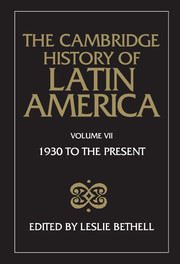14 - Panama since 1903
from PART FOUR - Panama
Published online by Cambridge University Press: 28 March 2008
Summary
Since its ‘discovery’ in 1501, the Isthmus of Panama has been a crossroads. During the Spanish colonial era mule trains carried cargo across the isthmus, connecting Spain with the Pacific. Annual fairs in the town of Portobelo on the Caribbean coast attracted agents from great merchant houses, as tons of Peruvian silver were traded for European goods. Even after the eclipse of the fairs Panama continued to thrive on commerce and shipping, in the eighteenth century still under Spanish rule and in the nineteenth century as a province of the independent republic of Colombia.
People of different backgrounds settled in Panama. The first Spaniards founded a handful of towns, divided Indians into encomiendas and farmed the best lands along the Pacific watershed. Several hundred of these families formed a rural oligarchy that was not particularly wealthy but controlled both land and people. In addition, the Spanish government designated Panama City as a key commercial and defence site in the Pacific, which it regarded as its private sea. Bureaucrats, military officers, merchants, seamen, artisans and African slaves dominated its population. Later, agents of Caribbean merchants also settled in Panama.
The colonial and nineteenth-century experience of Panama affected its history as a nation after 1903. There was an enduring tension between two elites, one rural and descended from the early settlers, often called interiorano; and another cosmopolitan, racially and culturally mixed, and based in Panama City and the northern transit port of Colón. Panama's multiple connections with the outside world brought people, capital and other benefits, yet also tied its fortunes to international economic cycles.
- Type
- Chapter
- Information
- The Cambridge History of Latin America , pp. 601 - 642Publisher: Cambridge University PressPrint publication year: 1990
References
- 11
- Cited by

